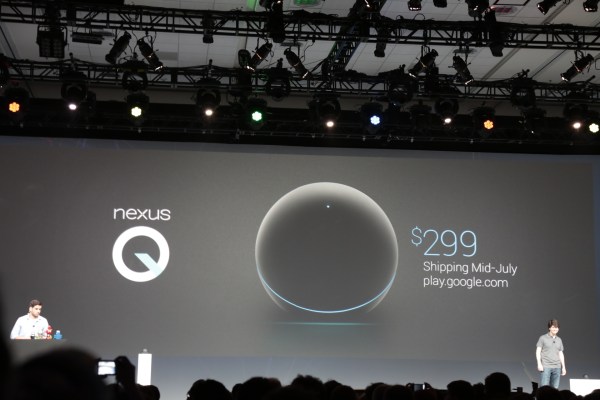It’s Day One of Google I/O, and the company set out to prove that it’s not just about software and algorithms and whatnot, introducing a neat set of hardware devices that are available — or will be soon — to take advantage of its Android mobile operating system.
Among other things, Google debuted the Nexus Q, a media-streaming device that will sell for $299 and connect with Android mobile phones and tablets. It also introduces the Nexus 7, an Asus-made 7-inch Android tablet that was pretty much built for consumption of content from Google Play. And then there was the company’s demonstration of Google Glass, which seems like more of a forward-looking experiment than anything else.
The company showed off some software as well, like Google Now, which provides users with real-time reminders and data on the fly. And it also showed off an updated version of Google+, which is designed to swallow up even more of your social graph, by adding calendar integration and the ability to go into “party mode” and instantly share photos with other Google+ users you’re at an event with.
But really, it was the hardware that stole the show.
The Shift From Software To Hardware
The whole thing seems like a bit of a departure for Google, which in the past was always happy to cede the hard work of building hardware to its partners, was content with showing off all the cool things that those partners could do with its software.
The Nexus Q, let’s not forget, is Google’s first foray into building its own hardware. But it won’t be Google’s last piece of hardware. After all, the company bought Motorola, maker of fine Android handsets and set-top boxes for the cable, satellite, and IPTV industry.
But there’s something deeper going on here, beyond just Google making gear. Take a close look at the Nexus Q and you realize that it’s pretty useless for doing anything as a standalone device. It is entirely dependent on the user to control it with an Android phone or tablet, and to be connected to Google Play to stream content from the cloud. The Nexus Q, in short, is positioned right in the center of a broader Google ecosystem, bridging the divide between Google’s software and cloud services and the hardware that depends on its Android OS.
Imitation Is The Sincerest Form Of Flattery
More than anyone over the last decade, Apple has been instrumental in showing how powerful an integrated set of hardware and software can be. Apple devices simply work better than most competing devices and its services are pretty well integrated into the iPhone and iPad.
The most obvious example of the Apple ecosystem is AirPlay, which lets user serve up content from their mobile devices — and soon their MacBooks and Mac desktops — directly to their TV screens through its $99 streaming box. But Apple announced at its latest WWDC developer conference that it is pushing the ecosystem even further, with greater cohesion between its Mac and iOS product lines. That includes more unified messaging and notification services that ping users regardless of the device that they’re using.
The Nexus Q might be a more expensive, less useful version of the Apple TV, but it also shows you how Google is thinking about its place as a hardware vendor and why it thinks it’s important to play in that space. It shows that Google recognizes the need to have an integrated ecosystem to compete against the likes of Apple.
Google’s Not Alone
Google isn’t the only player trying to bridge the divide between the mobile phone or tablet and the TV and all the services that sit in the cloud. Last week, Microsoft took the bold step of introducing some new hardware of its own, announcing its Surface tablet. And it had previously demoed Xbox SmartGlass, which is designed to connect mobile phones running Windows Phone software with its burgeoning Xbox Live media services.
Samsung, meanwhile, is taking a hybrid approach, selling Android phones and tablets but building APIs into its connected TVs that will provide tighter integration between the consumer electronics it sells. And Sony is trying to shoehorn its PlayStation Network onto whatever devices it sells.
The problem is that few companies succeed at building robust ecosystems of products, because few consumers have enough brand affinity to purchase gear from a single consumer electronics manufacturer. With the exception of Apple, no one has managed to truly translate success in one vertical into another. That’s the challenge Microsoft faces as it tries to convince its Xbox customers to also buy smartphones and tablets running its mobile OS. And it’s ultimately the challenge that Google will face as it tries to build an ecosystem of products that are extensions of its existing Android products.

